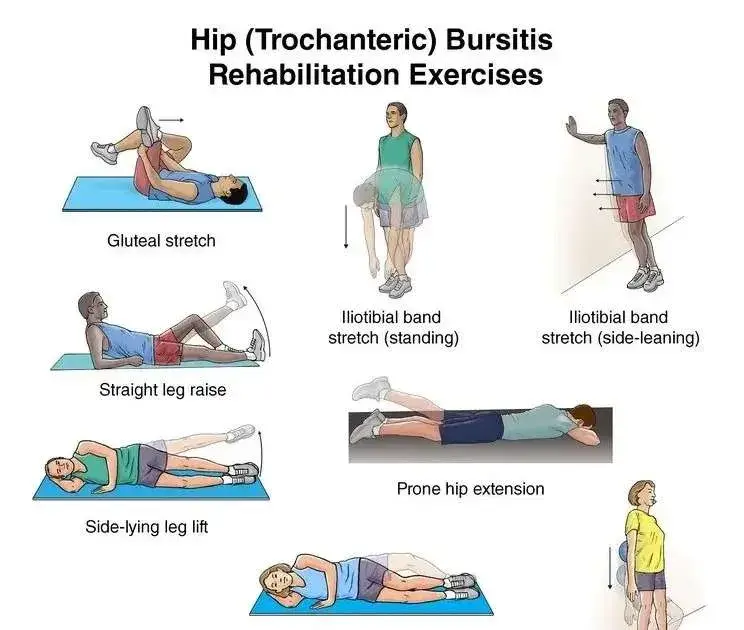Hip bursitis is a disorder brought on by inflamed bursae, which are tiny sacs filled with fluid that cushion the joints. The hip's bursae are close to the hip joint, between the bones, tendons, and muscles. Hip pain, soreness, and swelling can all result from inflamed bursae. The most frequent causes of hip bursitis include overuse, repeated motion, or hip injuries. Illnesses like gout arthritis, rheumatoid arthritis, or osteoarthritis may also bring it on. Age, past hip injuries, and specific jobs or sports that require repetitive hip motions are all risk factors for hip bursitis. Exercising with hip bursitis requires a careful balance between maintaining physical activity to prevent muscle weakness and avoiding movements that exacerbate the condition, such as excessive running or jumping. If you encounter hip bursitis symptoms, speaking with a healthcare professional is vital because timely treatment can help reduce discomfort and avoid problems. This blog will look at exercises to help with hip pain due to hip bursitis. Also Read: Hip pain in Women: 7 Possible Causes
Best Exercises for Relieving Hip Bursitis -
 Hip bursitis is a painful condition affecting the bursae, filled with tiny sacs and fluid cushioning the joints. Exercises that concentrate on the hip muscles can be used to reduce hip bursitis-related discomfort and inflammation. Exercising with hip bursitis requires a careful balance between maintaining physical activity to prevent muscle weakness and avoiding movements. Following are exercises that can help with pain are listed below:
Hip bursitis is a painful condition affecting the bursae, filled with tiny sacs and fluid cushioning the joints. Exercises that concentrate on the hip muscles can be used to reduce hip bursitis-related discomfort and inflammation. Exercising with hip bursitis requires a careful balance between maintaining physical activity to prevent muscle weakness and avoiding movements. Following are exercises that can help with pain are listed below:
- Flex your hips: Lean softly forward while kneeling on one knee with the other foot on top of you to stretch the hip flexors.
- Lie on your back with your bent knees and your feet crossed on the ground to perform the glute bridge. Squeeze your glutes as you raise your hips up and upward toward the ceiling.
- Clamshell: Lie on your side, your feet close together, and your knees bent. Lift your top knee higher while keeping your feet together.
- Straight-legged side-lying leg lift: Lie on your side. Lift your top leg to the ceiling without allowing your hips to roll back.
- Leaning forward while standing, stretch the hamstring of the elevated leg by placing one foot on a chair or bench.
- Stretching the piriformis muscle while seated involves crossing your legs and gently pulling the knee of the shank on the opposite shoulder.
- Wall squat: While standing with your back against a wall, squat down while maintaining a 90-degree bend in your knees.
- Standing calf stretch: Face a wall with your hands against it as you stand. To stretch your calf muscle, step back and press the heel of your rear foot into the ground.
- Standing quad stretch: To stretch the quadriceps, stand on one leg and gently draw the other foot towards your buttocks.
- Walking: Regular walking helps relieve hip bursitis discomfort and strengthen the muscles in the hips.
Before beginning an exercise program for hip bursitis, speaking with a doctor or physical therapist is necessary. They can suggest the most appropriate activities for your particular needs and recommend changes to prevent the issue from worsening. Read Also: Painful Joints: Understanding Bursitis
How to get relief from hip bursitis without exercising?
Hip bursitis is a painful ailment brought on by inflammation of the bursae, which are tiny sacs filled with fluid that cushion the joints. Here are some recommendations for treating hip bursitis:
- Rest: Giving the injured hip some rest can help the discomfort and inflammation subside. Avoid engaging in activities that worsen the illness, such as jogging or leaping.
- Compression: Applying an elastic bandage or compression wrap to the injured hip can help reduce swelling and support it.
- Elevation: Reducing edema and inflammation by elevating the afflicted hip.
- Medication: non-prescription painkillers like inflammatory medications such as acetaminophen or ibuprofen
- Physical therapy: You can learn stretching and strengthening, and exercising with hip bursitis can help with muscles with a physical therapist.
- Injections: A physician may sometimes advise a corticosteroid injection to lessen pain and inflammation.
If you have hip bursitis, you should see a doctor right away so they can provide an accurate diagnosis and suggest the best course of action for you. Also Read: Total Hip Replacement: For Comfort & Functionality
How does bursitis in the hip feel?
Joint discomfort and pain are symptoms. Additionally, the affected area may enlarge and feel heated. In the first five days, the discomfort is frequently severe. It may be sharp for the first few days.
Which therapies are most effective for hip bursitis?
The severity of the hip pain will determine the best treatment for hip bursitis. The following are some popular treatments for hip bursitis:
- Rest Therapy: Giving the injured hip some rest can help the discomfort and inflammation subside. Avoid engaging in activities that worsen the illness, such as jogging or leaping.
- Icing the area: You can apply ice for ten to fifteen minutes every day, several times. Using ice on the injured hip will help lessen pain and swelling.
- Compression or warm compress: Applying an elastic bandage or compression wrap to the injured hip can help reduce swelling and support it.
- Medication: Over-the-counter anti-inflammatory medications such as acetaminophen or ibuprofen can lessen pain and inflammation. Prescription drugs such as corticosteroids or biologics could be required in some circumstances.
- Physical therapy: You can learn stretching and strengthening exercises for the hip muscles from a physical therapist, or exercising with hip bursitis is the best way to deal with this condition.
- Injections: A physician may sometimes advise a corticosteroid injection to lessen pain and inflammation.
- Surgery can help deal with pain and swelling, and pus-filled infections.
For advice on the best action for your hip bursitis condition, speak with a doctor or physical therapist.
Conclusion-
When the bursae, tiny sacs packed with fluid and located close to the hip joint, become inflamed, it results in hip bursitis, a painful ailment. Hip pain and tenderness, especially when moving, running, or ascending stairs, are the most common signs of hip bursitis. Hip bursitis can have various reasons, but most frequently result from overuse or repetitive hip joint motions, such as those associated with running, cycling, or prolonged standing. Hip bursitis can also develop due to additional conditions, including an injury, arthritis, or infection. Hip bursitis can be treated in several ways: rest, ice, anti-inflammatory drugs, physical therapy, and corticosteroid injections. In addition, surgery can help remove the inflamed bursa. But you should contact Orthopedic Doctor in Ballery before taking any steps for surgery.
Frequently Asked Questions
How to get rid of hip bursitis?
The initial treatment can insult reducing inflammation by resting and taking NSAIDs.
What are the symptoms of hip bursitis?
Some symptoms of hip bursitis include pain, localized tenderness, and limited motion in the hip region.
Does hip bursitis go away?
Hip bursitis often goes away after the infection is gone in the hip area.
What is the fastest cure for hip bursitis?
The fastest cures for hip bursitis include resting the affected area, applying an ice pack, and taking pain relievers.
Is walking good for hip bursitis?
Exercising with hip bursitis can help improve joint pain and be crucial to managing bursitis symptoms.

Reviewed by







